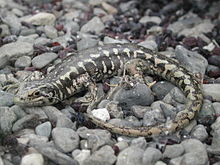Otago skink
| Otago skink | |
|---|---|

| |
| Scientific classification | |
| Kingdom: | |
| Phylum: | |
| Class: | |
| Order: | |
| Suborder: | |
| Family: | |
| Genus: | |
| Species: | O. otagense
|
| Binomial name | |
| Oligosoma otagense McCann, 1955
| |

| |
The Otago skink, Oligosoma otagense, is an endangered species of large skink of the family Scincidae, found in the central Otago region of New Zealand.
Physical characteristics
Otago skinks are large compared to other New Zealand skinks, capable of growing to lengths up to 12 inches (31 cm). They are marked with distinctive black, yellow, and green spots, which provides excellent camouflage in their rocky habitat of lichen-covered rocks and schist outcrops. The juveniles can be identified with more of a yellow base with dark blotches and shorter limbs. Like most skinks, Otago skinks are omnivores and feed on a wide variety of insects, fleshy fruits, flower petals, or even other small reptiles.[2] They are long lived, reaching around 16 years in the wild (up to 40 years in captivity) and are slow to mature (3 to 4 years). Unlike many reptiles, this species develops in the mother's body and holds live births[3] to 3 or 4 independent of young in January to March each year.
Habitat

Otago skinks are only found in very specific locations in Otago. The majority of the species can be found on the eastern portion, usually up to 1,000 meters in elevation. However, a smaller population inhabits the western sides of Otago. Although the two populations are morphologically similar, there has been speculation as to whether they have undergone genetic variation. A phylogeographic analysis conducterd by Chapple et al. examined the genetics of the subpopulations. It suggests that there is a speration in lineages, but geneflow still occurs in neighboring locations. The study advises that the two regions be assessed and treated separately.
The skinks are typically limited to the large schist rock outcroppings found in that region. They can often be seen sunning themselves on these rocks and seek refuge in the deep crevices when alarmed, at night and on cold days. As of the year 2000, the range of the Otago skink has decreased by roughly 90% when compared to the estimated historic range. Although it was once widespread, land use change, particularly the intensification of farming, and the introduction of mammalian predators has led to a decline in the population.
Conservation status
As of 2012 the Department of Conservation (DOC) classified the Otago Skink as Nationally Endangered under the New Zealand Threat Classification System.[1] Work to identify the causes of decline is ongoing, as are protection efforts through habitat protection, predator-proof fencing and predator control.[4] Anthropogenic threats along with natural traits, (like low productivity and late sexual maturity), all compile to threaten the species. Additionally, the skink requires strict habitat standards that are limited near its natural origin, leaving the populations isolated and small. A management trial was developed in 2005 that lead to a major population recovery. Habitat conservation, predator control, and program monitoring became major objectives and have since proved successful as the numbers are slowly increasing. The Otago skink is currently fully protected under the New Zealand Government , making it an offense to harm. The DOC aims to continue efforts for management in situ, but some captive management has been carried out by breeders, organizations, and zoos to ensure preservation from natural catastrophe.[5]
References
- ^ a b Hitchmough, Rod; Anderson, Peter; Barr, Ben; Monks, Jo; Lettink, Marieke; Reardon, James; Tocher, Mandy; Whitaker, Tony. "Conservation status of New Zealand reptiles, 2012" (PDF). Department of Conservation. The Government of New Zealand. Retrieved 18 July 2015.
- ^ (DOC), corporatename = New Zealand Department of Conservation. "Grand and Otago skinks: Lizards". www.doc.govt.nz. Retrieved 2016-12-04.
- ^ "Oligosoma otagense". The Reptile Database. Retrieved 2016-12-04.
- ^ Norbury, Grant. "Mokomoko Dryland Sanctuary". Landcare Research - Manaaki Whenua. Landcare Research - Manaaki Whenua. Retrieved 18 July 2015.
- ^ (DOC), corporatename = New Zealand Department of Conservation. "Grand and Otago skinks: Lizards". www.doc.govt.nz. Retrieved 2016-12-04.
- Template:IUCN2006 Listed as Vulnerable (VU C2a v2.3)
- Journal of the Royal Society of New Zealand, Volume 27, Number 4; pp 439–450.
External links
 Media related to Oligosoma otagense at Wikimedia Commons
Media related to Oligosoma otagense at Wikimedia Commons Data related to Oligosoma otagense at Wikispecies
Data related to Oligosoma otagense at Wikispecies- Video of Grand and Otago skinks
- Draft Recovery Plan for Grand and Otago skinks
- Otago skinks discussed on RadioNZ Critter of the Week, 26 August 2016

